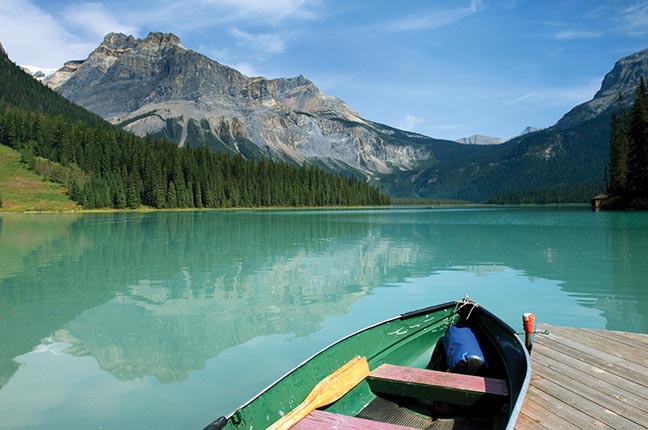Travel Canada

East, West, Home Is Best
Make our nation your destination
By Vanessa Roset
You’ve heard the saying, “Not all those who wander are lost.” It is the globetrotter’s mantra, often printed on inspirational travel posters designed to lure us abroad. But how often do we wander in our own backyards? From coast to coast, Canada has a wealth of adventure to offer the budget backpacker and savvy spender alike. So go ahead, get lost a little. We’ve got some tips to get you going, no matter how you’re getting there.
Oh, Canada!
If you’re looking for an exciting escape this summer, think local. Travelling at home has many advantages, such as avoiding long border crossings and expensive exchange rates. Not sure you’ll find what you need? Consider this: Canada boasts the world’s longest coast line and has somewhere around two million freshwater lakes. The imposing Rocky
Mountains stretch 1200 km within the country alone, extending nearly all the way to the Yukon Territory. Between our east and west borders are 17 UNESCO-recognized world heritage sites, 40 protected national parks and myriad native plant and animal species. With all of it accessible through a reliable transportation network, it’s a wonder we ever leave home at all.
Hit the Road
Canadians who love the freedom and spontaneity of road trips are spoiled with a number of inviting options. The Trans-Canada Highway—the longest national highway in the world—is 7,821 km long and runs from Victoria, BC to St. John’s, Newfoundland. There are plenty of scenic alternatives, too: the Pacific Rim Highway (BC), the Frank MacDougall Parkway (ON) and the epic Viking Trail (NL). Our recommendation: make note of areas with long distances between gas stations and bathrooms,and bring your favourite pillow so you can relax comfortably while enjoying the view.
Tip: GPS systems and Wi-Fi aren’t always available, especially along mountain ranges or less populated areas, so think paper. The Alberta Motor Association provides its members with complimentary TripTiks, a travel plan you create online and they print and mail to you based on your personalized itinerary. TripTiks include maps, attractions, accommodation information, detailed driving instructions—even road construction warnings and detour information. The added roadside assistance perks make getting a membership before any road trip a no-brainer.
RV There Yet?
Travelling with your own bed offers a certain degree of peace of mind. However, it’s best not to leave overnighting to chance—particularly if you have a larger rig that’s harder to accommodate. Sites with RV hookups and services are often fully booked weeks ahead of time, so planning is key. Many provincial campgrounds are first-come, first-served, and popular areas fill up early. Plan your arrival times accordingly, allowing for unexpected maintenance stops and sightseeing along the way.
Tip: A little feng shui goes a long way when sharing a small living space with others. Use space-saving tricks to cut down on clutter: buy collapsible kitchenware (like colanders), and free up cupboard space by removing packaging before stocking the pantry. Limiting the number of toys kids can have out at any time and leaving others in storage until the next rotation will also cut down on clutter.
A Train of Thought
For a truly exceptional way to see our home and native land, take the train. VIA Rail has 19 routes running cross-country and travel options that suit all budgets. Take advantage of economy seating or treat yourself to the unique luxury of a sleeper car, which comes with showers and other extras. Full-service restaurants, lounge cars, onboard activities and observation areas make train travel a treat. A great budgeting option for long-distance travellers is the CanRail pass, which allows passengers to choose their own itinerary through a set number of one-way trips or unlimited travel within a specified timeframe. Musicians can apply to the Artists on Board Program, which offers free or discounted train travel in exchange for performances.
Tip: The dining car can get expensive, so bring a portable cooler with snacks, and do grocery runs during longer stops. Just remember that passengers have access to hot water but not to fridges or microwaves. To stay comfy, bring slippers and non-restrictive clothing, earplugs, a blanket for chilly nights and plenty of entertainment.
Leaving on a Jet Plane
For those more interested in the destination than the journey, flying remains the most efficient way to travel. Big-time budgeters can find great deals through websites like Expedia, Kayak, RedTag and Orbitz. For the best prices, start searching for flights early and often, and keep an eye out for flash sales. If you don’t want to do all the legwork, hire a professional. For a small fee your local travel agent will do all the research and can help you reschedule should a flight get delayed or rerouted. Consider also joining your favourite airline’s loyalty club; you’ll collect points with each trip, enjoy membership benefits and increase your chances of getting a free flight upgrade.
Tip: Pack light. Travelling with just a carry-on means you’ll save on baggage fees and get to avoid long lines at baggage claim and check-in. It also guarantees you’ll arrive with all your possessions in tow.
Nautical Nation
Few summer activities beat boating on a hot day. Luckily, plenty of opportunities exist for water lovers of all levels. You could kayak on one of Manitoba’s picturesque lakes, paddle and camp along the banks of Alberta’s Bow River or head to the West Coast where thousands of islands beckon curious explorers to their unspoiled shorelines. Local favourites include the Gulf Islands, Desolation Sound and the Princess Louisa Inlet. Take a day trip from Granville Island into Howe Sound, or travel around the Broughton Archipelago Provincial Park for weeks. Rent a speedboat, a sailboat, even a houseboat! Just remember, proper safety certification is required for anyone operating a power-driven boat in Canada.
Tip: Cut fuel costs by shedding unnecessary boat weight and by travelling with the wind instead of against it. Boats burn more fuel in high seas and at high speeds. Accelerate slowly, idle less and fill up early in the morning when fuel is colder and denser—you’ll get more bang for your buck.
More Like This
Backyard Home Theatre
Read
Edmonton From Above
Read
‘Motoring’ around Edmonton
Read





